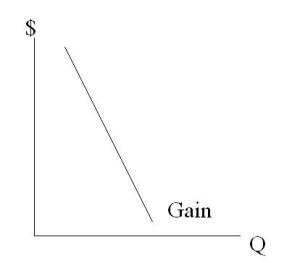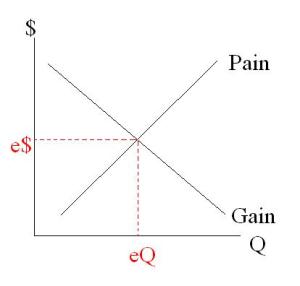NO PAIN NO GAIN
The Anatomy of a Motto
Major Gressingham FRCO, FCC, Bar
“No Pain, No Gain” – How oft are those words spoken by many a PE teacher, Army General, hiker and athlete, but do we actually know what it means? If it is true that there is no gain with out pain how can we judge if we are getting sufficient gain from the pain to justify undertaking the activity at hand?
In the following paragraph I will attempt to answer just those questions and along the way provide an explanation of The Pain/Gain Theory, a theory that finds its strongest proponent in the work of Sir William Wilmot who outlined the details to me whilst we rambled through the Gloucestershire countryside one day in May 2009. It struck me then, as I hope it will soon strike you, how the theory can be described in terms originally coined for the science of macro-economics, and in applying the workings of that noble discipline to the Pain/Gain theory we can rationalise something that previously had been product of instinct.
The Gain Line
If we were to plot gain as a line it would look something like this:
FIGURE A

Q is the amount of gain, the Quantity. Strictly speaking $ is the amount of money you would be willing to pay for each of the corresponding units of gain although it may be more useful to think of it in terms of how much energy you would choose to expend in acquiring each additional unit of gain. Thus, for any point along the gain line we can say exactly how much one would be willing to pay (or how much energy one would expend) for each of the units of gain that fall along the line.
The line is downward sloping because of the law of diminishing marginal returns. That law states that the more of a good one has the less we are willing to pay for it. For example, if you have a proclivity for Mars Ice Creams you might derive a great benefit from your first bar of the day. That pleasure may even carry through to the second bar. By the time you are stuffing your face with ice cream number three, you may start to get weary. Come number ten you may well be completely indifferent to Mars Ice Creams. Talking in terms of deriving benefit is the same as talking in terms of price. In other words you would be willing to pay £1.20 for your first ice cream as you would get £1.20 worth of pleasure. By the time you reach Ice cream number nine you may think each helping is only worth £0.30 because you are deriving less benefit from each further bar. This concept explains why a student will gain much more pleasure from a tenner than will a millionaire who sleeps on a mattress stuffed with tenners.
Now that we understand why the line is downward sloping we need to consider its gradient. The steepness of the line reflects what is termed the elasticity of gain. The steepness of the line reflects the loss of benefit as an additional unit of gain is acquired.
FIGURE B

A comparison of Figure A and Figure B illustrates the concept of elasticity. The gain line in Figure B is relatively steeper than that of figure A. This means that benefit derived for each extra unit of gain in Figure B is less than that in figure A. So for example the unit of gain in Figure B may be linked to an activity such as masturbation. The benefit from the first wank is high, but the gain from the second is very much less and pretty much after that all you want to do is go to sleep. The gain in Figure A is most likely linked to a less benefit intensive activity such as eating a bag of kettle chips. The benefit from the first crisp is high, and the second is less good but in a dramatically smaller way than the second wank; the gain from eating additional crisps does drop, but much more gently possibly until the whole bag has been eaten. Thus the line in Figure B is steeper, or more elastic than the line in figure A.
Perfect elasticity or inelasticity of gain can exist. So for instance the gain line may be totally inelastic (horizontal) for an activity such as breathing, because each breath you take does not make you want to take the next one less. One never tires of breathing, and as each breath is critical the line is perfectly inelastic; breathing therefore, is not subject to the law of diminishing marginal returns. Gain may theoretically be perfectly elastic (vertical) , although the circumstances are hard to imagine. It would involve gain relating to an activity which you would want to do just once and never again because there would be no benefit to you from one more until of gain – perhaps taking one’s own life might be an example.
The Pain Line
Pain is an altogether different beast, and the concept of plotting the pain line stretches the economics analogy to its limit. Yet it holds true.
FIGURE C

Here again Q is the quantity or amount of pain. When thinking about $ on the y axis we must think not of money, but of energy. So if the amount of energy expended (be it physical, emotional, or mental) on an activity is high the pain will be high, this is a function of the upward slop of the line.
As with gain, the pain line is elastic. It may be more elastic (steeper) when the extra energy involved in the activity increases the pain by a lesser amount than a relatively inelastic line (flatter). Computer gaming would have a steep pain curve, as even a huge increase in energy will be accompanied by only a small increase in the amount of pain. Conversely, mountaineering is an activity with a flatter pain line as a small increase in the energy expended will result in a relatively larger amount of pain.
The Pain Gain Equilibrium
Having an understanding of the shape of the pain and gain lines allows us to map the equilibrium point. When looking at the following graphs you need to think of $ as the value of the experience not necessarily in monetary terms, although how much you would have to pay for the experience is a handy way of thinking about the concept.
FIGURE D

The equilibrium point is where the pain line crosses the gain line and is thus a product of the interaction of pain and gain. This is the point of greatest efficiency. At this point you are experiencing the maximum amount of gain for the most efficient amount of pain. Put another way, the pain to gain ratio is at its most economical. Thus e$ is the worth you are deriving from the activity in question whereas eQ is the amount of pain and gain that will be experienced.
Thus when doing an activity we can now check using this method whether we are experiencing enough gain for the level of pain we are experiencing, and also a fair price for undertaking the pursuit can be calculated (if for instance you wanted to charge others to do the activity with you).
For illustrative purposes you can see in Figure E how the elasticity of one of the lines will effect the pain/gain outcomes.
FIGURE E

As illustrated, if the gain line is relatively more elastic (steeper) the equilibrium point is closer to zero, thus less value is achieved as the commensurate gains will be lower than a relatively less elastic gain line activity.
Shifts in the Pain/Gain Lines
If there is a shift in either of the pain or gain lines the equilibrium point will shift accordingly.
FIGURE F

A parallel shift in the pain curve in an upwards direction is effectively an easing of conditions of pain. So for example a hiker may have a day’s rest at which point the nasty blister on his right foot and the knob rot that set in somewhere just past Cirencester have had a chance to heal. Thus at value level e$1 the amount of pain will be less. However, the shift in the pain line means that the equilibrium point where the pain and gain lines interact also shifts. So we see that when this happens the value f the experience is increased to e$2 there is less pain but critically, also less gain eQ2.
This really is the crux of the pain/gain theory, and is also its most controversial tenet because what we are in fact saying is that the hiker who had a blister and knob rot was actually experiencing more gain with those ailments despite the pain being greater.
The pain line may also shift downwards for example if a skier twisted his leg and had to ski on it for the remaining 4 days of the family holiday to St Moritz.
FIGURE G

There can also be shifts in the gain curve as we can see in figure G. an upward shift would indicate an improvement in circumstance which increases gain and value without requiring any extra effort; an example would be when cycling from John O’Groats to Lands end, the exact moment you left Scotland and entered England would be an upward gain line shift. The exact reverse is true and a downward shift the result when cycling from Lands End to John O’Groats.
Figure G then illustrates both a pain line shift and a gain line shift. Initially the equilibrium point is eQ1 with value e$1. Then an upward pain line shift (improvement in pain conditions) moves the equilibrium to eQ2 with value e$2, if there is then an upward shift of the gain line also the equilibrium point returns to eQ1, so the pain and gain is the same as it was initially before pain conditions improved and there was a change of scenery or other gain curve shifting event, but the value of the experience has increased. This is called Pleasure Inflation.
A Note on Meanings
The author is of the opinion that there is scope for considerable confusion in much of the above paragraphs due to the similar meanings or connotations attaching to the words gain and value or worth. So although for example in Figure G when we are at equilibrium eQ2 and value e$2 the amount of gain (eQ2) is lower than when we are at eQ1, and yet the value e$2 is higher than e$1. Thus we can see that gain and value are not necessarily positively correlated. Value is a monetary type evaluation whereas gain is a more esoteric type of benefit.
The value of an experience is a product not of how much gain there is, but of how a certain amount of gain interact with the corresponding amount of pain. If the combination is just right it needn’t matter that the amount of gain is smaller, the experience will still have a relatively higher value or worth.
Conclusion
Pain and Gain have been understood by humans since the dawn of time, but much like the functioning of the markets we had an intuitive understanding without any technical foundations. I have broken down the wall of ignorance and formalised what has for centuries been based on divination.
With my handy and easy to use graphs you can make sure you are getting the most out of your life at any given moment.